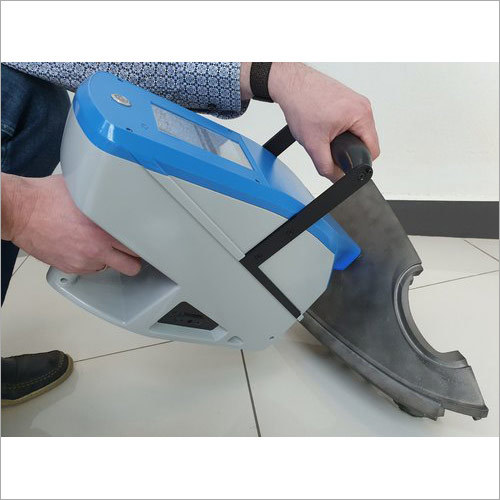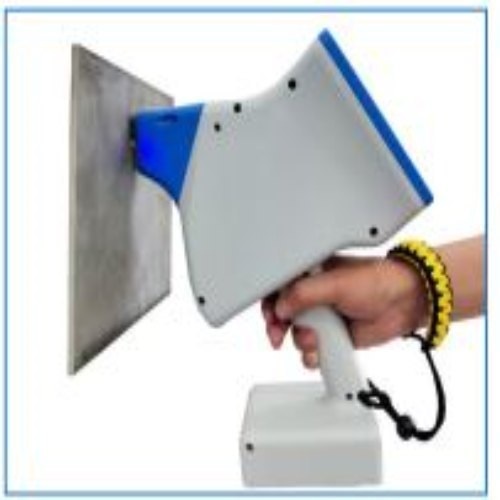Handheld XRF Metal Analyzer
1000000 INR/Unit
Product Details:
- Power Rechargeable Battery Operated
- Usage Auto Testing Machine
- Function Metal Alloy Composition Analysis
- Accuracy High (0.01%)
- Product Type Handheld Xrf Metal Alloy Analyzers
- Operating Mode Portable
- Control Mode Handheld / Manual
- Click to View more
X
Handheld XRF Metal Analyzer Price And Quantity
- 1 Unit
- 1000000 INR/Unit
Handheld XRF Metal Analyzer Product Specifications
- High (0.01%)
- Metal Alloy Composition Analysis
- Rechargeable Battery Operated
- Handheld / Manual
- Auto Testing Machine
- ASTM, ISO
- Portable
- Handheld Xrf Metal Alloy Analyzers
- Gray & Blue
Handheld XRF Metal Analyzer Trade Information
- 1000 Unit Per Day
- 1 Week
Product Description
A handheld XRF (X-ray fluorescence) metal analyzer is a portable device used for elemental analysis of various materials, particularly metals and alloys.
Handheld XRF Metal Analyzer Applications:
1. Mining and Exploration: Handheld XRF analyzers are used in mining operations and exploration activities to quickly determine the elemental composition of rock samples, ores, and soil. This helps geologists and mining engineers make decisions about resource estimation, ore grade control, and exploration targeting.
2. Metals Recycling: In the scrap metal recycling industry, handheld XRF analyzers are used to sort and identify different metal alloys quickly and accurately. This enables scrap yards to efficiently separate valuable metals for recycling and ensures compliance with quality specifications.
3. Manufacturing and Quality Control: Handheld XRF analyzers are employed in manufacturing processes to verify the composition of metal components and ensure they meet quality standards. This is especially important in industries such as automotive, aerospace, and electronics manufacturing where the properties of materials are critical for product performance and safety.
4. Environmental Monitoring: XRF analyzers are used for environmental monitoring and assessment of soil, sediment, and water contamination. They can detect trace elements and heavy metals, helping environmental scientists and regulators assess pollution levels and identify sources of contamination.
5. Construction and Building Materials: Handheld XRF analyzers are utilized in the construction industry to assess the elemental composition of materials such as concrete, ceramics, and coatings. This information is crucial for ensuring compliance with building codes, identifying potential hazards, and assessing the quality of construction materials.
6. Archaeology and Cultural Heritage: In archaeology and cultural heritage conservation, handheld XRF analyzers are used to analyze the composition of archaeological artifacts, paintings, sculptures, and historical objects. This helps researchers understand the materials used in cultural artifacts, assess their authenticity, and plan conservation strategies.
7. Forensics and Criminal Investigations: Handheld XRF analyzers play a role in forensic science and criminal investigations by analyzing trace evidence such as gunshot residues, paint chips, and metal fragments. This helps forensic analysts identify the elemental composition of materials found at crime scenes and provide evidence for criminal cases.
8. Food and Agriculture: In agriculture, handheld XRF analyzers are used for soil analysis to assess nutrient levels and soil fertility. They can also be used for elemental analysis of plant tissues to monitor nutrient uptake and diagnose nutrient deficiencies.
Handheld XRF Metal Analyzer Specifications:
1. Display: 5 Inch Color Touch Screen Display
2. Working Spectral Range: 177-380 nm
3. Source of Radiation: Pulsed DPSS Laser1064 nm
4. Memory: 32 GB
5. Measurement Point Size: 50 Microns
Powerful Metal Analysis on the Go
This handheld analyzer is engineered to deliver laboratory-grade accuracy in a compact form. Its integrated silicon drift detector and robust X-ray tube provide broad elemental analysisfrom Mg to Umaking it ideal for alloy and material identification in the field or at the factory. The automatic radiation shielding and a powerful rechargeable battery maximize both safety and portability.
Comprehensive Data Management and Connectivity
Equipped with internal memory, USB export, and Bluetooth capabilities, this analyzer simplifies data storage, transfer, and reporting. The user-friendly high-resolution LCD display and integrated software allow immediate access to results and customizable analysis reports. Adhering to international ASTM and ISO standards, the device is perfectly suited for quality assurance and compliance documentation.
FAQs of Handheld XRF Metal Analyzer:
Q: How does the Handheld XRF Metal Analyzer perform metal composition analysis?
A: The analyzer uses a high-performance silicon drift detector (SDD) and an X-ray tube to excite and identify elements within metal alloys. It scans the sample, measures characteristic X-ray emissions, and delivers a precise elemental breakdown in just 1-10 seconds.Q: What is the typical process for conducting a metal alloy test with this device?
A: Simply place the analyzers measuring head on the sample surface, select the test mode, and press the trigger. The integrated software handles data acquisition and analysis, displaying results on the high-resolution LCD within seconds. Results can be saved to internal memory or exported via USB or Bluetooth.Q: When is it most beneficial to use this handheld analyzer in industrial applications?
A: This device is invaluable for quick, accurate alloy verification during raw material inspection, production quality control, sorting of scrap metals, and compliance testing, especially in environments requiring rapid decision-making and minimal sample preparation.Q: Where can the analyzer be utilized considering its portability and ruggedness?
A: Thanks to its lightweight design and operating temperature range of -20C to 50C, the analyzer is suitable for use in factories, warehouses, scrap yards, construction sites, and even harsh outdoor environments, ensuring reliability wherever metal analysis is required.Q: What safety features are included to protect the operator?
A: The device incorporates automatic radiation shielding that activates during measurement, minimizing exposure risk. Additionally, its battery-operated, cable-free design further enhances hands-on safety during field or manual operation.Q: How accurate are the measurements provided by this analyzer?
A: The analyzer offers high accuracy with a margin of 0.01%, ensuring highly reliable results that comply with ASTM and ISO industrial standards for material analysis.Q: What are the main benefits for exporters, manufacturers, or suppliers using this device in India?
A: Users benefit from rapid, on-the-spot metal identification, seamless data export, compliance with international standards, and adaptability for a range of industrial needsall supported by robust construction and comprehensive documentation features.Tell us about your requirement

Price:
Quantity
Select Unit
- 50
- 100
- 200
- 250
- 500
- 1000+
Additional detail
Mobile number
Email
 English
English Spanish
Spanish French
French German
German Italian
Italian Chinese (Simplified)
Chinese (Simplified) Japanese
Japanese Korean
Korean Arabic
Arabic Portuguese
Portuguese



 Call Me Free
Call Me Free
